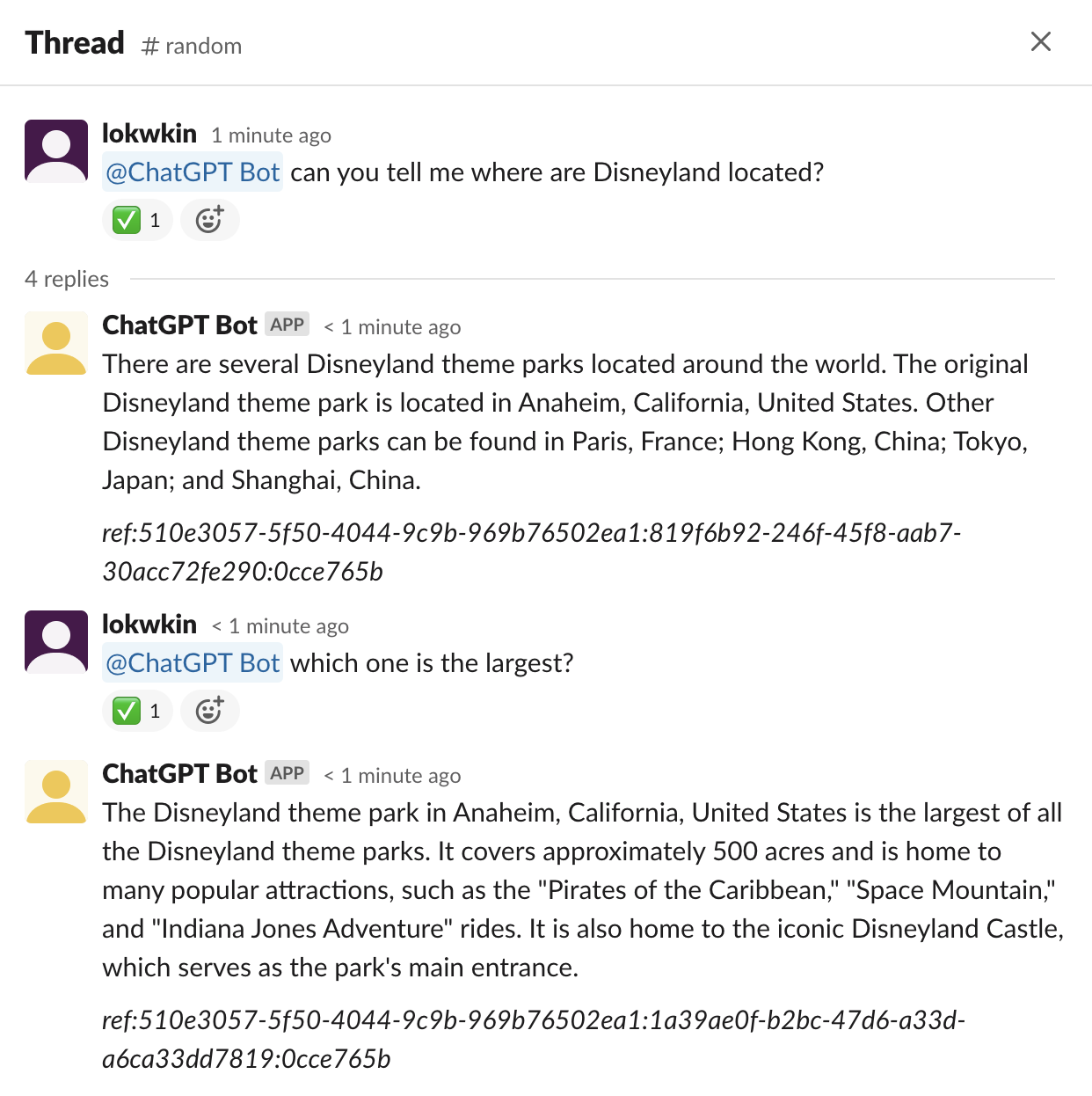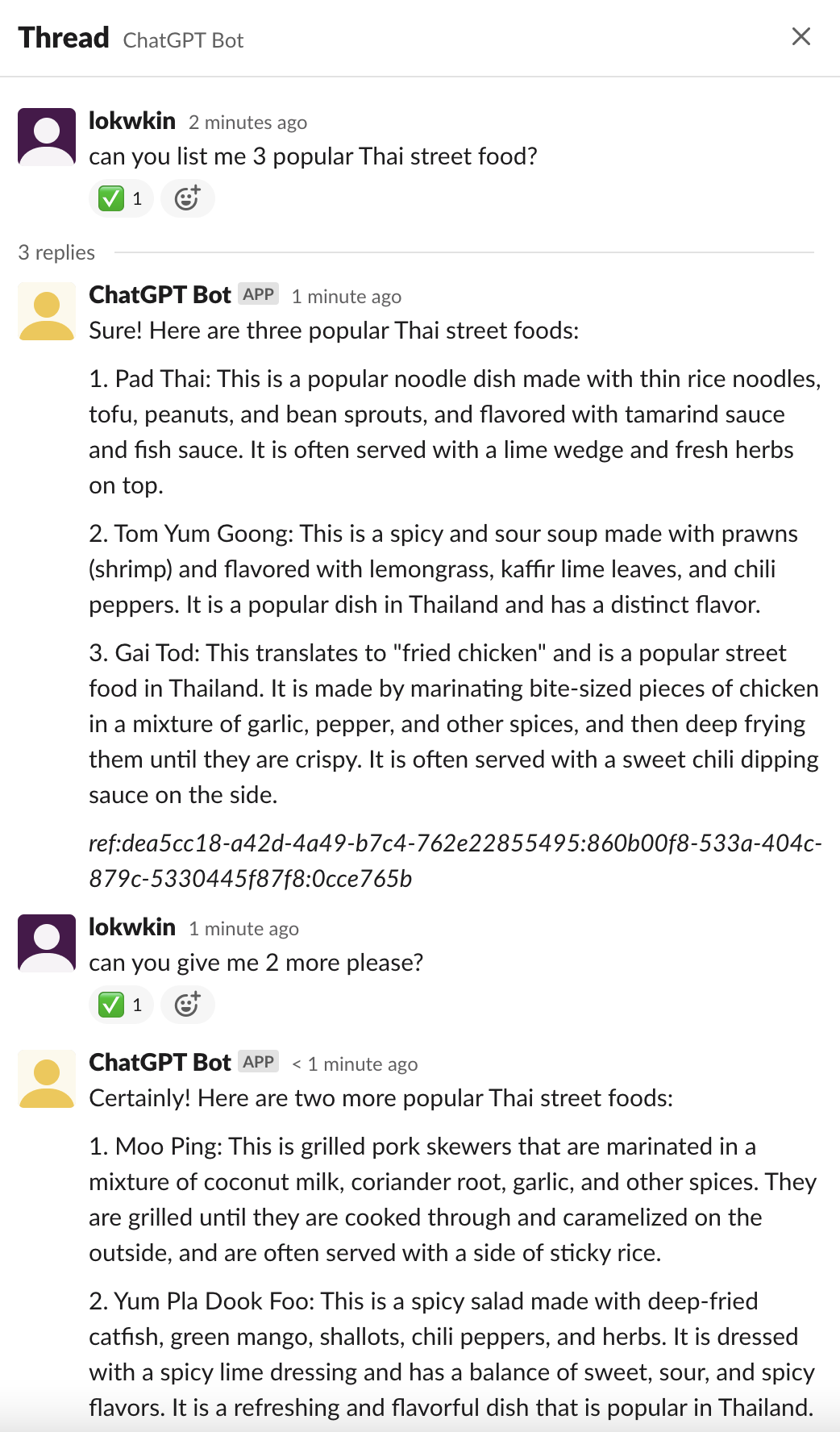ChatGPT Slack Bot
This Slack Bot is implemented in Node.js, under the hood it depends on transitive-bullshit/chatgpt-api, which uses puppeteer browser as solution to connect with ChatGPT.
This service is docker containerized and can be deployed onto servers with headless chromium browser without an active display. (Suggested to use google login in order to bypass recaptcha)
It also incorporates queue mechanism with redis, so that it is more flexible to handle request spikes, make sure the requests are sent one by one and in order to protect from being rate limited by ChatGPT.
Usage
- The slackbot will listen to two types of event in slack workspace
- Directly message the bot in slack.
- Mention your bot in a channel with a question. For example:
@ChatGPT BOTwho is Donald trump?
- To ask follow up question, reply in the answer thread, otherwise it will treat it as a new question.
Mention in Channel
Direct Message
Start Modes
This app has two modes to start:
slackbot- listens to slack event for user requests, put request to redis queue, reply to slack on answer received.chatgpt- serves as queue worker that listens to queue, forward user's questions to chatgpt, and put response back to queue on answer received.
Setup
Slack Setup
- Register an Slack App in portal
- "Socket Mode" -> Enable Socket Mode
- "OAuth & Permissions" -> Grant these permissions:
app_mentions:read,channels:history,chat:write,im:history,im:write,reactions:write,groups:history - "Event Subscription" -> "Subscribe to bot events" -> Add
message.imandapp_mention - "App Home" -> "Message Tab" -> Check "Allow users to send Slash commands and messages from the messages tab"
- Obtain your Bot Token from "OAuth & Permissions" > "Bot User OAuth Token"
- Obtain your App Token from "Basic Information" > "App Level Token"
- "Install App" -> Reinstall to workspace if neccessary
Build and run with docker
docker build -t chatgpt_slackbot .
docker run chatgpt_slackbot
Environment Variables
START_MODE=slackbot
| Key | required | description |
|---|---|---|
START_MODE |
Y | slackbot |
REDIS_URL |
Y | Redis connection url, e.g.: redis://127.0.0.1.6379 |
SLACK_BOT_TOKEN |
Y | Your Slack Bot token. See https://api.slack.com/ |
SLACK_APP_TOKEN |
Y | Your Slack App token. See https://api.slack.com/ |
SLACK_BOT_USER_ID |
Y | The User ID of your Slack Bot. See https://api.slack.com/ |
SLACK_REACTION_LOADING |
N | The emoji to react when loading a question, default thinking_face |
SLACK_REACTION_SUCCESS |
N | The emoji to react when the prompt is answered, default white_trade_mark |
SLACK_REACTION_FAILED |
N | The emoji to react when failed when processing, default x |
CHATGPT_RESPONSE_QUEUE_NAME |
N | Queue name to use for listening for ChatGPT answers, default queues.answers.slackbot |
START_MODE=chatgpt
| Key | required | description |
|---|---|---|
START_MODE |
Y | chatgpt |
REDIS_URL |
Y | Redis connection url, e.g.: redis://127.0.0.1.6379 |
CHATGPT_EMAIL |
Y | The email of your chatgpt account |
CHATGPT_PASSWORD |
Y | The password of your chatgpt account |
CHATGPT_PROXY_SERVER |
N | e.g.: 12.123.234.345:23456, leave it blank if not used |
CHATGPT_IS_GOOGLE_LOGIN |
N | 1 or 0, default 0 |
CHATGPT_REQUEST_TIMEOUT_MS |
N | Timeout value for chatgpt request. default 300000 (5min) |
Suggetions
Running it from cloud servers like AWS / GCP / Azure, etc, will lead to receiving 429 error quickly. Or make use of proxy / VPN services if you insists to.



